Amazon Revs Up Ecommerce Packaging Designs
Ecommerce packaging is getting more sustainable and efficient through Amazon’s expanded Frustration-Free Packaging program. But the clever new designs are what really wow shoppers.
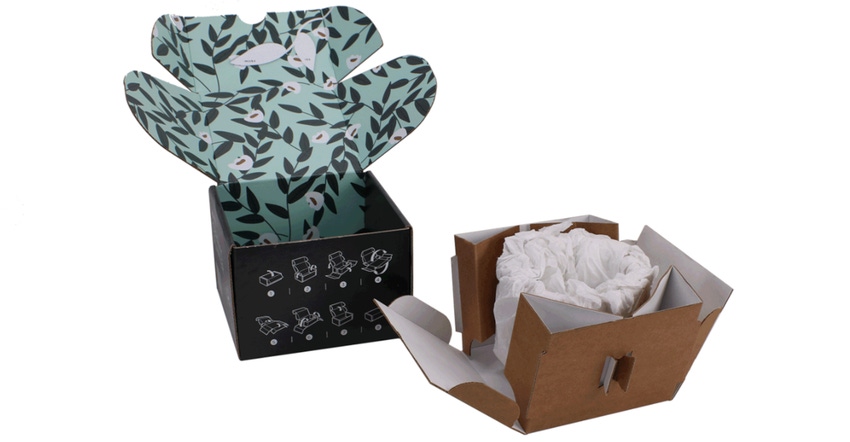
Ecommerce packaging development and improvement took another leap forward in June 2021, when Amazon announced an expansion of its Frustration-Free Packaging (FFP) program. Now, half a year later, we not only get a progress update, but we get to see some ingenious packaging designs — like reversible, inside-printed gift boxes and other results from successful brand/supplier/Amazon partnerships.
Vincent Barral, Principal, Frustration-Free Packaging, Customer Packaging Experience, Amazon, gives Packaging Digest an exclusive inside look at some FFP wins, tools, and knockout designs.
It has been about half a year since its introduction. How is the expanded FFP incentive program going so far?
Barral: We have received very positive feedback from our vendors whose curiosity and knowledge about Frustration-Free Packaging is growing. We have experienced a sharp increase in traffic on our Frustration-Free Packaging (FFP) website and in outreach of vendors to the FFP team at Amazon. We see vendors adopting FFP principles more holistically, not only by packaging development teams, but also by product development teams, who are adopting FFP requirements for new product launches, along with Amazon’s Compact by Design and other Climate Pledge Friendly certifications.
What has been the reaction from vendors?
Barral: Vendors are delighted with the additional support Amazon is offering on FFP, such as the new Frustration-Free Packaging website, which centralizes the resources needed for them to convert products to FFP. The site includes vendors and customers’ benefits, training videos, the directory of our Packaging Services and Supplier Network (APASS), the incentive calculator, the step-by-step certification process guide, certifications guidelines, and featured case studies for inspiration.
Vendors were also thrilled with the extension of our financial incentives program in North America into smaller-sized products, and the opportunity for self-testing. These two new program features combined allow for lower-volume and lower-price-point products to be converted to FFP easily, at reduced costs, delighting customers with less packaging and more functional packaging.
More vendors also see the opportunity to differentiate their products with less packaging that can better protect their products from damage throughout the ecommerce supply chain, and be used as gift-wrapping, activate their brands at the customer's doorstep, contribute to their brands' sustainability objectives and messaging, reduce their logistics and packaging costs, or replicate the traditional retail unboxing experience.
Some brands create omnichannel FFP packages that combine the demands of traditional retailers with a delightful ecommerce customer experience. Amazon and the Amazon’s Packaging Support and Supplier (APASS) Network provide support and incentives to vendors to convert their packaging into these creative solutions.
What challenges are you seeing or hearing about from vendors? How are you addressing those challenges?
Barral: It’s hard for some consumer goods manufacturers’ packaging teams to forget what they have learned for many decades: designing packaging that appeals to consumers from a store shelf. This change of paradigm may take an adjustment. A good way to trigger change is to rely on outside support to transition to ecommerce packaging. The packaging design firms of the Amazon’s Packaging Support and Supplier (APASS) network come in handy, to foster innovation, and enhance customer experience.
The most successful engagements between brands and packaging design firms are those that start with brands sharing their customers’ needs, their objectives, pain points, and concerns. Third party packaging design firms will listen, ask questions, address concerns, overcome blockers, and meet the brands’ needs with innovative designs.
Tell us more about the open-source packaging concepts Amazon will share with vendors through its partnership with the APASS Network design firms. How will this work?
Barral: To support vendors and sellers in certifying their products under Amazon’s Frustration-Free Packaging Programs, Amazon provides a list of companies and labs — the Amazon’s Packaging Support and Supplier (APASS) Network — that can help test, design, and supply packaging in line with meeting Amazon’s Packaging Certifications. All companies included have received guidance from Amazon and many have already worked with manufacturers to design, supply, and test Amazon Certified Packaging. The essential services these companies and labs provide are: Packaging Testing, Packaging Supply, and Packaging Design.
To inspire our vendors with how functional, fun, and differentiating FFP is for customers, Amazon engages with the APASS Network packaging design firms, packaging materials suppliers, and some vendors in innovation partnerships to develop these concepts. We may require vendors to commit to a reasonable FFP conversion roadmap of their Amazon assortment, complying with FFP standards, testing, and piloting innovative designs. The entire project usually takes about 90 days from first engagement to approval of the new packaging production.
The reversible packaging printed inside with brand messaging is an example of this design partnership, right?
Barral: Correct.
The reversible packaging printed inside offers the possibility to vendors to activate their brands (such as with a printed logo) and message customers on the sustainability benefits of this new packaging. Customers can reverse these boxes into, for example, a traditional retail print (shoes animation), a gift wrap print (planter), or a print that accessorizes the product (truck toy with packaging that serves as a garage).
These examples show how ecommerce packaging can offer a better experience to customers than traditional retail packaging, but also a consistent experience across traditional and ecommerce retail channels. Protective ecommerce packaging can be re-used by customers since it’s more robust.
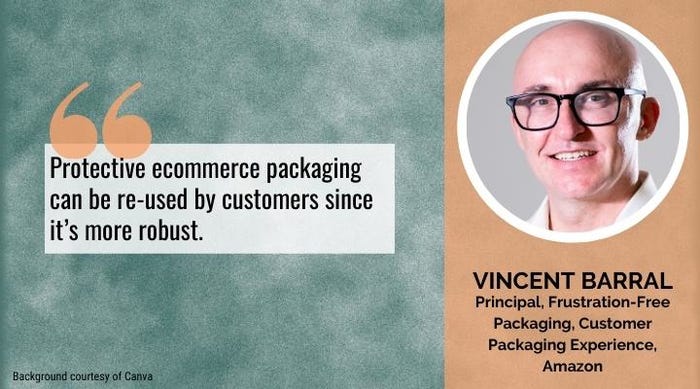
In the last year or so, COVID-19 paused or slowed a lot of businesses/projects, of course. But why such a gap between the original launch in Sept 2018 and this expansion in 2021?
Barral: The pandemic delayed the expansion of this program, but we have not stopped innovating on behalf of our customers. Since 2015, Amazon has reduced the outbound packaging weight per shipment by 36% and eliminated over one million tons of packaging material, the equivalent of over two billion shipping boxes. Our orders are increasingly delivered in lighter packaging.
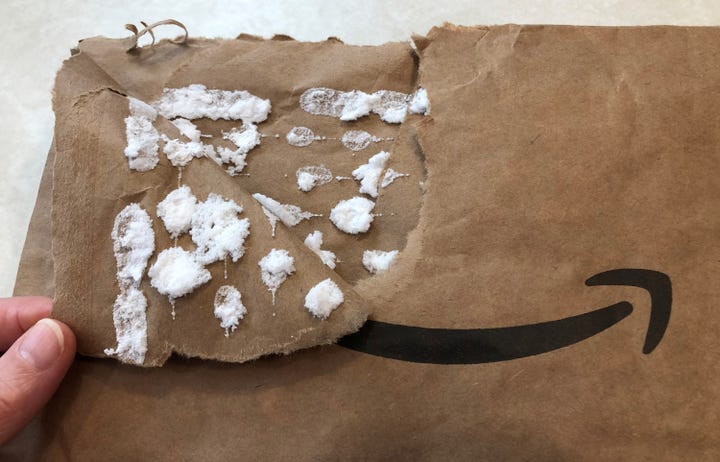
Packaging Digest executive editor received one of the new recyclable mailers for a shipment this holiday season.
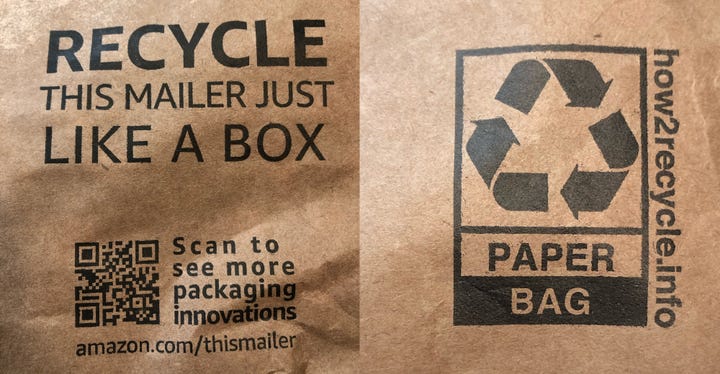
For example, in 2019, we launched a fully recyclable paper padded mailer that protects products during shipping while taking up less space in transit. The recyclable mailer is made of multiple layers of paper and a water-based cushioning material using components commonly found in the glue used to make corrugated board. The lightweight recyclable cushioning was specifically designed to easily separate from the paper in the same way that print inks and other paper coatings are removed during the paper recycling process. This ensures customer deliveries arrive undamaged and in recyclable packaging with a lower carbon footprint.
Now, more than 400 million of the new mailers have been shipped to customers, reducing waste, saving fuel, and offering the same recyclability as Amazon’s iconic box, without taking up nearly as much space in a recycling bin.
What investments in technology are helping Amazon advance its FFP program and how?
Barral: We have invented machine-learning algorithms to help us make the smartest packaging choice for customer orders. That means identifying which products don’t need packaging at all, and which products are less fragile, and hence suitable for envelopes, folders, bags, or mailers. In cases where the protection of a box is needed, algorithms help us continuously optimize box choices to fit our ever-changing catalog. Computer-aided engineering also helps us redesign boxes to use less material while making sure customer orders are protected.
These improvements reduce packaging materials consumption and volume per shipment, which means less packaging and more efficient use of all forms of transportation, reducing carbon emissions to create a larger impact across our network.
Reducing package size and designing for cube efficiency are similar tasks, but not quite the same thing, at least for products that ship via pallet loads in trucks. How are these different for small-parcel distribution? And which is more important to Amazon for direct-to-consumer shipping and why?
Barral: Amazon focuses on cube efficiency, which reduces package size but not at the expense of protecting products. At Amazon, we obsess over delighting customers with undamaged products and minimal packaging.
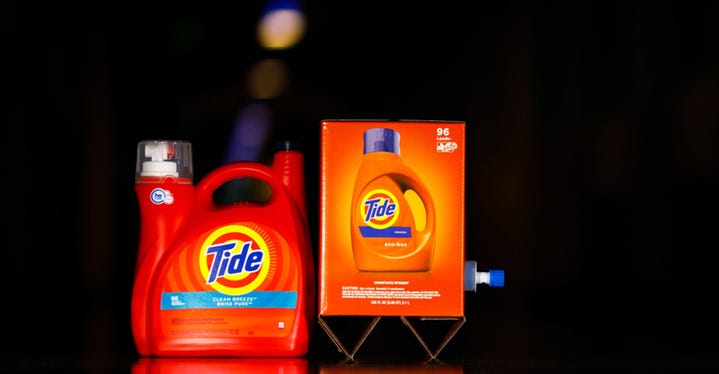
Tide Eco Box
Amazon has shown examples of successful ecommerce packaging changes — the Tide Eco Box, for one. What hasn’t gone well, and why? What are you doing to make it work?
Barral: Throughout the process to innovate and create new packaging, vendors may require several iterations as the first trial is not always successful. Certifying items for FFP requires the vendors’ packaging to pass a physical performance test, which allow them to identify if a product packaging will be able to arrive to the customers’ hands undamaged. Amazon has partnered with the International Safe Transit Association (ISTA) to develop comprehensive test methods that accurately simulate the journey of a package through the Amazon fulfillment network, and Amazon now offers the option to self-test.
How is Amazon defining “recyclable” for the FFP incentive program?
Barral: In all regions, we are working to eliminate or reduce packaging, and to increase recycling — including access to it. Amazon’s iconic box is curbside recyclable, and we have worked with partners to develop a fully recyclable paper padded mailer for customer orders. We’ve shipped more than 200 million of these to customers, and we’ll continue scaling the use of this packaging where it is compatible in our fulfillment process.
We’ve also made continued progress on eliminating or reducing packaging materials. We use 36% less raw materials to ship each package than we did six years ago, and that is continuing to decline. We also recognize we have room for improvement – we are moving to packaging material options that are fully compatible either in the paper or plastic recycling streams. Each region will have different approaches based on the supply chains in those regions, including logistics difference in our fulfillment teams, partners, vendors, and access to recycling.
How does participation in the FFP incentive program benefit vendors by lowering their packaging and inbound transportation costs?
Barral:Our Frustration-Free Packaging (FFP) Programs encourage vendors to package their products in easy-to-open packaging that is 100% recyclable and ready to ship to customers without additional Amazon packaging.
There are three cumulative components of the expanded Frustration-Free Packaging incentive program: newly certified packages that meet tier 1 and 2 certification tiers, and that reduce dimensional volume from existing package size. Total incentives range from $0.08 - $6.49 per certified unit shipped between October 1, 2021, and December 31, 2022, in North America.
Converting to FFP reduces packaging volume, which not only allows vendors to collect incentives, but also helps them reduce costs by placing more products in storage, in trucks, airplanes, or vessels, and decrease their warehousing, transportation, and packaging materials costs, while enhancing their customer experience. Vendors can estimate their incentive payments on the Amazon FFP website.
How much time will FFP-compliant packaging save at Amazon fulfillment centers by reducing/eliminating over-boxing or speeding up the pick-and-ship process?
Barral:Although we do not disclose specifics, optimizing packaging allows us to spend more time innovating to delight our customers.
What estimated costs will be eliminated for Amazon, again by reducing/eliminating over-boxing?
Barral:Although we do not disclose specifics, optimizing packaging allows us to invest more in innovating to delight our customers.
How will this FFP program expansion help Amazon reach its goal of net zero carbon by 2040?
Barral:FFP programs ensure that our packages use as a little material as possible and are right sized to protect customers’ orders. Smaller and lighter packages mean Amazon can pack more orders into each delivery, resulting in fewer trips, less fuel burned — all of which minimize our carbon footprint.
How will packages designed for the FFP program help lower product damage rates and returns?
Barral: To certify a product with either tier of FFP packaging with Amazon, it must pass the ISTA6 test that simulates the stress endured as it travels through the ecommerce supply chain to our customers. By testing products in a dedicated, state-of-the-art lab in Seattle, in APASS Network testing labs, in our fulfillment centers across the globe, or by educating vendors to self-test products in their own facilities, we can determine whether a package can withstand the stress of the ecommerce supply chain, and minimize damages on products.
When a product fails the ISTA 6 test, APASS Network members (test labs, structural packaging design firms, and packaging materials suppliers) or the Amazon Packaging Lab can help identify specific steps that vendors can take to improve their packaging and ensure products are protected all the way to the customer’s doorstep. This helps, in turn, reduce product damage rates and returns, and delight our customers with undamaged orders.
Through its Frustration-Free Packaging program, Amazon has worked with vendors and packaging suppliers to optimize ecommerce packaging in three ways:
1. Improve the customer’s experience.
2. Minimize the environmental impact of packaging, which includes reducing the amount of packaging.
3. Lower the cost of delivering goods.
How are you measuring the impact of the FFP program in these areas, especially one (1) and three (3)?
Barral:Improving customer experience is at the center of everything we do. Our sophisticated systems allow us to identify via customer insights, such as reviews and return rates, what product packaging needs improving and what product packaging is delighting our customers.
Since 2015 we’ve reduced the weight of outbound packaging by 36% and eliminated more than 1 million tons of packaging material, the equivalent of 2 billion shipping boxes. We report on our sustainability commitments on our annual Sustainability report.
About the Author(s)
You May Also Like




